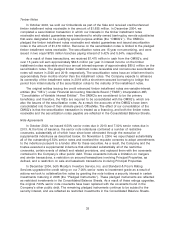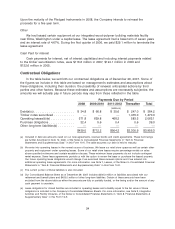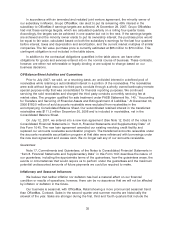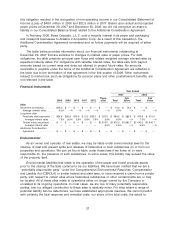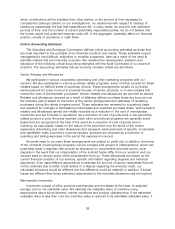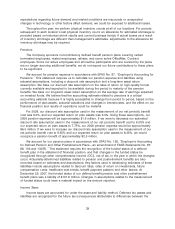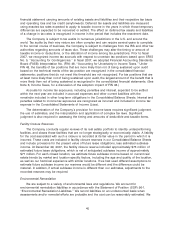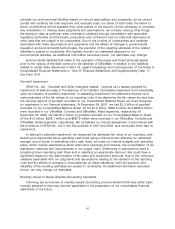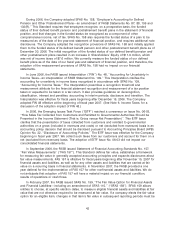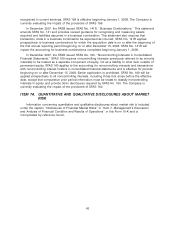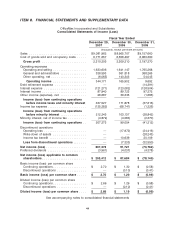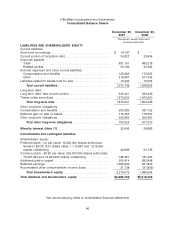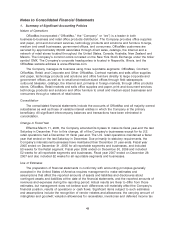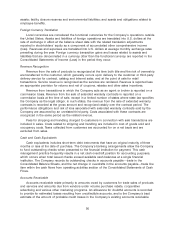OfficeMax 2007 Annual Report Download - page 46
Download and view the complete annual report
Please find page 46 of the 2007 OfficeMax annual report below. You can navigate through the pages in the report by either clicking on the pages listed below, or by using the keyword search tool below to find specific information within the annual report.During 2006, the Company adopted SFAS No. 158, ‘‘Employer’s Accounting for Defined
Pension and Other Postretirement Plans—an amendment of FASB Statements No. 87, 88, 106 and
132(R).’’ This Standard requires that employers recognize, on a prospective basis, the funded
status of their defined benefit pension and postretirement benefit plans in the statement of financial
position, and that changes in the funded status be recognized as a component of other
comprehensive income, net of tax. SFAS No. 158 also requires the funded status of a plan to be
measured as of the date of the year-end statement of financial position, and requires additional note
disclosures. The Company adopted the recognition provisions of SFAS No. 158 and initially applied
them to the funded status of its defined benefit pension and other postretirement benefit plans as of
December 30, 2006. The initial recognition of the funded status of our defined benefit pension and
other postretirement plans resulted in an increase in Shareholders’ Equity of $11.9 million, which
was net of income taxes of $7.6 million. We currently measure the funded status of our defined
benefit plans as of the date of our fiscal year-end statement of financial position, and therefore, the
adoption of the measurement provisions of SFAS No. 158 had no impact on our financial
statements.
In June 2006, the FASB issued Interpretation (‘‘FIN’’) No. 48, ‘‘Accounting for Uncertainty in
Income Taxes—an interpretation of FASB Statement No. 109.’’ This Interpretation clarifies the
accounting for uncertainty in income taxes recognized in accordance with SFAS No. 109,
‘‘Accounting for Income Taxes.’’ The Interpretation prescribes a recognition threshold and
measurement attribute for the financial statement recognition and measurement of a tax position
taken or expected to be taken in a tax return. It also provides guidance on derecognition,
classification, interest and penalties, accounting in interim periods, disclosure and transition. The
Interpretation was effective for fiscal years beginning after December 15, 2006. The Company
adopted FIN 48 effective at the beginning of fiscal year 2007. (See Note 6, Income Taxes, for a
discussion of the adoption impact of FIN 48.)
In 2006, the Emerging Issues Task Force (‘‘EITF’’) reached a consensus on Issue No. 06-03,
‘‘How Sales Tax Collected from Customers and Remitted to Governmental Authorities Should be
Presented in the Income Statement (That is, Gross versus Net Presentation)’’. This EITF Issue
clarifies that the presentation of taxes collected from customers and remitted to governmental
authorities on a gross (included in revenues and costs) or net (excluded from revenues) basis is an
accounting policy decision that should be disclosed pursuant to Accounting Principles Board (APB)
Opinion No. 22, ‘‘Disclosure of Accounting Policies.’’ The EITF Issue was effective for the Company
beginning in fiscal year 2007. We collect such taxes from our customers and account for them on a
net (excluded from revenues) basis. The adoption of EITF Issue No. 06-03 did not impact our
consolidated financial statements.
In September 2006, the FASB issued Statement of Financial Accounting Standards No. 157,
‘‘Fair Value Measurements’’ (‘‘FAS 157’’). This Standard defines fair value, establishes a framework
for measuring fair value in generally accepted accounting principles and expands disclosures about
fair value measurements. FAS 157 is effective for fiscal years beginning after November 15, 2007 for
financial assets and liabilities, as well as for any other assets and liabilities that are carried at fair
value on a recurring basis in financial statements. In November 2007, the FASB provided a one
year deferral for the implementation of FAS 157 for other nonfinancial assets and liabilities. We do
not anticipate that adoption of FAS 157 will have a material impact on our financial condition,
results of operations or cash flows.
In February 2007, the FASB issued SFAS No. 159, ‘‘The Fair Value Option for Financial Assets
and Financial Liabilities—including an amendment of SFAS 115,’’ (‘‘SFAS 159’’). SFAS 159 allows
entities to choose, at specific election dates, to measure eligible financial assets and liabilities at fair
value that are not otherwise required to be measured at fair value. If a company elects the fair value
option for an eligible item, changes in that item’s fair value in subsequent reporting periods must be
42



